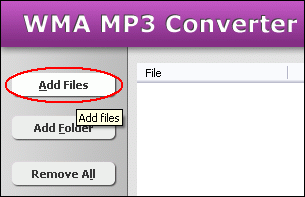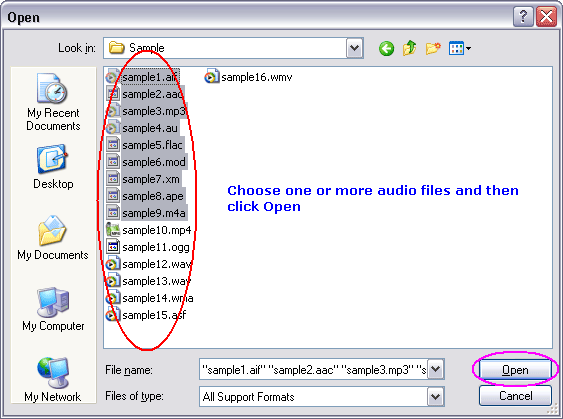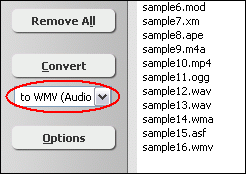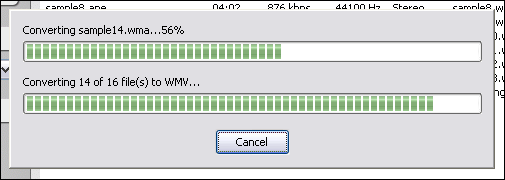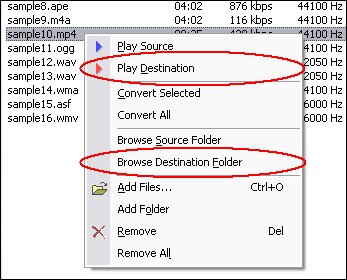EAC3 to WMVConvert EAC3 to WMV, EAC3 to WMV Converter |
 |
| Home | Getting Started | Download | Buy Now! | Screen Shots | FAQ | Support | Contact |
EAC3 to WMV Converter converts EAC3 to WMV. The software is an ALL-IN-ONE audio converter that supports more than 100 audio and video files. EAC3 to WMV Converter supports batch conversion and, is full compatible with Vista and Windows 7.
What is EAC3? Dolby Digital Plus bitstreams are not backward compatible with legacy Dolby Digital decoders, and decoders that output audio over legacy S/PDIF connections must transcode the bitstreams to an older format such as PCM, AC-3, or DTS. The codec used by Dolby Digital Plus is based on the original Dolby Digital codec, but with several enhancements to improve coding efficiency:
Dolby claims that these changes can result in bitrate improvements of up to 50% while still allowing for the signal to be efficiently converted to Dolby Digital for backwards compatibility. What is WMV? A WMV file is in most circumstances encapsulated in the Advanced Systems Format (ASF) container format. The file extension .WMV typically describes ASF files that use Windows Media Video codecs. The audio codec used in conjunction with Windows Media Video is typically some version of Windows Media Audio, or in rarer cases, the deprecated Sipro ACELP.net audio codec. Microsoft recommends that ASF files containing non-Windows Media codecs use the generic .ASF file extension. The ASF container can optionally support digital rights management using a combination of elliptic curve cryptography key exchange, DES block cipher, a custom block cipher, RC4 stream cipher and the SHA-1 hashing function. Although WMV is generally packed into the ASF container format, it can also be put into the AVI or Matroska container format. The resulting files have the .AVI and .MKV file extensions, respectively. WMV can be stored in an AVI file when using the WMV 9 Video Compression Manager (VCM) codec implementation. Another common way to store WMV in an AVI file is to use the VirtualDub encoder. Windows Media Video (WMV) is the most recognized video format within the WMV family. Usage of the term WMV often refers to the Microsoft Windows Media Video codec only. Its main competitors are MPEG-4 AVC, AVS, RealVideo, DivX, and Xvid. The first version of the codec, WMV 7, was introduced in 1999, and was built upon Microsoft's implementation of MPEG-4 Part 2. Continued proprietary development led to newer versions of the codec, but the bit stream syntax was not frozen until WMV 9. While all versions of WMV support variable bit rate, average bit rate, and constant bit rate, WMV 9 introduced several important features including native support for interlaced video, non-square pixels, and frame interpolation. WMV 9 also introduced a new profile titled Windows Media Video 9 Professional, which is activated automatically whenever the video resolution exceeds 300,000 pixels (e.g., 528x576, 640x480 or 768x432 and beyond) and the bitrate 1000 kbit/s. It is targeted towards high-definition video content, at resolutions such as 720p and 1080p. Convert EAC3 to WMV Related Topics: AAC to WMV, ALAW to WMV, WV to WMV, RMJ to WMV, CAF to WMV, W64 to WMV, GSM to WMV, ULAW to WMV, RA to WMV, MIDI to WMV, F4A to WMV, XM to WMV, AC3 to WMV, S3M to WMV, WAV to WMV, CDA to WMV, MOD to WMV, ALAC to WMV, M1A to WMV, SPX to WMV, AWB to WMV, IT to WMV, SOL to WMV, AU to WMV, WMA to WMV, CD to WMV, SND to WMV, MPP to WMV, ADX to WMV
|
| Home | Getting Started | Download | Buy Now! | Screen Shots | FAQ | Support | Contact | Links |
| Copyright © 2007-2014 Hoo Technologies All rights reserved. Privacy Policy |
